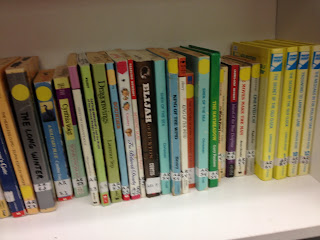Initial Cost- The Cheapest Route
The initial cost of cloth diapers depends largely upon the route you take with what type of diaper you'd like. To save the most money possible, you will need to make your own prefold cloth diapers from flannel and cotton inserts (see your local fabric store for more details, and sales, for that one). You'll need a set of little plastic pants and safety pins too. This is the most labor intensive route, as you'll have to fold, pin, and pants your baby every time you change her, but it will only cost about $50 for your baby's entire diapering career. That's right, ONLY FIFTY BUCKS! This is how my mom cloth diapered my sister and me, and my mother in law diapered four of her 6 kids with this same method. With a little sewing, diaper origami, and washing, this is by far your cheapest diaper choice and will save you an average of about $1,900!
Spendy Start-Ups
Buying a set of fitted diapers, plus their spendy designer covers is the most expensive way to go. It gets even worse if you buy a set of non gender-neutral ones or trendy designs that will be out of style and useless for any subsequent children. While there are a TON of super cute cloth diaper covers, the less expensive ones tend to leak and the more expensive ones... are more expensive! This method of cloth diapering may cost around $700. You're still going to come out ahead of the average expensive disposables which cost around $1,000 for the first year, $2,000ish for the pre-potty trained years total. There are even designer cloth diapers that cost over $100 for ONE DIAPER! Obviously if you go that route, you're not going to come out ahead if you buy the average number of cloth diapers (around 24 diapers total) unless you use them for multiple kids.
We bought our set of Bum Genius pocket diapers for $150 on Craigslist. We got 20 diapers, 30 large inserts, and 24 small inserts. This was a steal of a deal as Bum Genius usually go for around $18 each new, making that lot about $360. I also got about 14 newborn diapers from the Just Between Friends sale in Portland, Oregon for about $20. We decided to try to only use disposables on trips or when other people babysit our little one, Grace, but we've ended up only using them at night and with people who don't babysit her often. Because we got a number of packs of disposables for baby shower gifts, we haven't had to buy any diapers yet, and won't need to until she's around 5-6 months. For the first few days of Grace's life, when we got to enjoy the sticky, tar-like meconium poo, we stuck with disposables so we wouldn't have to try and get that ickyness off the cloth diapers.
Start the Search!
To get some nice cloth diapers for a better price, check around on Craigslist, second hand children's stores, or at baby sales, like the Just Between Friends sales. The sooner you start, the pickier you can be about getting a great deal. If they are velcro (hook & loop) closure, you will want to make sure that the velcro isn't worn out, or that you know someone with some crafty skills to replace the velcro. Check that they are in pretty good shape, because you'll be using them a lot! Check out http://www.handmade-adelaide-baby.com/best-cloth-diapers.html for more detailed information about the types of diapers that are available.
Savings in the Wash
Wet Vs. Dry Pails
If you place your cloth diapers into a wet pail (I love Bambino Mio's locking diaper pail) with some water and a sprinkling of Borax after you rinse them off in the toilet, you should be able to skip the recommended first rinsing stage that you normally have to do when laundering cloth diapers. You will want to get a locking pail so your little one doesn't drown in the diaper water! This presoaking will save a few dollars a month in electric and water bills. I usually rinse the diaper & insert in the toilet (just swish it around in the bowl until most of the debris comes off), and then toss them in the wet bucket. To save even more money, you don't have to flush the debris immediately, but just wait until the next time that someone needs to use the restroom, and then flush it down with everything else! I have an extra bucket to fill up with the cold water that first comes out when you turn on the shower, which I use to fill my wet pail, so then I'm not wasting any water while waiting for the shower to warm up either!
Mix It Up for More Savings!
If you mix your regular laundry in with your cloth diaper laundry (or even your little one's dirty duds), you'll save even more money! In general, our culture uses WAY too much detergent, and I've never had a problem with our clothes coming out clean, even with this small amount of detergent (the extra rinses probably help). I wash really dirty things, like logging/hiking/gardening gear or the dog's bedding & towels separately, but everything else gets mixed in together and comes out nice and clean. By washing everything together, you save precious time, money, water, and electricity! Remember that you'll want to do a full wash, something like this:
Pre-Wash (Doing this will allow you to skip the first rinse and spin cycle below)
*Remove diaper & rinse in toilet.
*Separate insert, unsnap snaps, and stick Velcro to washing
tabs.
*Place in Borax water bucket to soak & wash within three
days.
Wash
*Drain most of diaper-soak water into toilet.
*Place all diapers into washer & turn dial to Rinse
& Spin. Select Cold/Cold water
temp. Press Start. (You can skip this step if you use a wet pail to soak the diapers in before washing them)
*Add 1 heaping teaspoon of sensitive skin/free detergent.
*Turn dial to Super Wash.
Select Hot/Cold water temp.
*Push the Max Extract and Extra Rinse buttons and press Start.
Dry
Ideally: hang dry everything on the drying rack outside in
full sunlight with the inside of the diaper facing the sun.
Or: Turn dial to Delicate & choose Low temp. Hang anything that is still damp on the
railing upstairs.
An energy and water efficient front loading machine will be most cost-effective in the long run, but it will probably be wise to wait until your old washer dies until buying a new one. Drying your diapers on a rack will further increase your savings. Even if you just dry the inserts or the diaper shells on a line or rack, that will still reduce the amount of time your other clothes will need in the dryer.
Your Thoughts?
How do you save money when diapering your little one? Do you have any tricks for getting things ultra-clean on a dime? What else do you do to save money with your baby? Leave a comment below, and share this with a friend to help them save some serious cash!








































